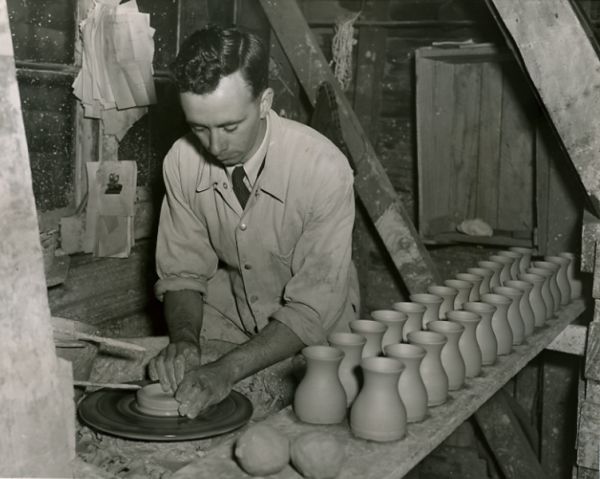 |
 |
|
Potters and Potteries
The production of pottery ware began soon after settlement in Hobart. By 1816, ex-convict James Brammer had established a pottery, using moulds to produce tobacco pipes and other items. A long-lasting pottery was established in Lenah Valley in 1831 by James Sherwin, who produced a range of homewares. From 1867 William Ellis then in the 1880s Alexander Worbey rented this site; Worbey produced studio-ware, often unglazed, with a characteristic brown glaze and vine leaf decoration Port Arthur also had a pottery, operated by convicts from the early 1840s until at least 1870. Its wares were displayed in exhibitions, at times supplied the government's wants in Port Arthur and Hobart, and were sold to the Hobart public. From 1886 to 1912 at his Brickfields Hill pottery James Price produced a range of pipes, tiles and domestic wares. His restored kiln stands on the right of the Port Arthur site entrance. Probably the most remote pottery in Australia was operated by Richard Hill in his water-powered sawmill just above the last rapid on the Kermandie River between 1851 and 1852. Wares were shipped to Hobart for sale. In the late 1840s Henry Yeates began manufacture in Longford, producing a large assortment of wares and selling them in Launceston. Launceston became the centre of Tasmanian pottery manufacture with the establishment of two potteries which grew into large businesses producing art, domestic and industrial ware. In 1873 John McHugh started by selling his terracotta flowerpots and saucers about Launceston on horseback. Alfred Cornwell won a contract in 1874 to supply Launceston Council with saltglazed pipes for the sewerage system. John Campbell bought the company in 1881 and developed it into Tasmania's largest pottery. Both potteries enjoyed their heydays between the 1920s and the outbreak of the Second World War, and no Tasmanian pottery has rivalled their size since. McHugh and Campbell never fully recovered after the war and both were only producing pipes and fittings when they ceased production in 1968 and 1976 respectively. Their richly glazed decorative wares can often be found in antique shops and homes today. Maude Poynter is recognised as Tasmania's first studio potter. She began potting in 1918 on her brother-in-law's Ratho property at Bothwell. Her functional and brightly coloured woodfired ware, often with Australian plant and animal decorations, was given as gifts, or sold from two Hobart outlets. She taught her cousin, Violet Mace, who potted at Ratho from 1920 until 1942. Mace's later forms and glazes were strongly influenced by the Chinese style and she was one of the earliest potters to introduce Aboriginal motifs. Mylie Peppin, another student of Maude Poynter, produced a large variety of wares in Hobart from 1935 until her death in 1992, and is fondly remembered by many as an inspiring teacher. Further reading: G Ford, Australian pottery, Wodonga, 1995; M Graham, Australian pottery of the 19th and early 20 th century, Sydney, 1979; V Hammond (ed), Australian ceramics, Shepparton, 1987. Frank Conrow |
Copyright 2006, Centre for Tasmanian Historical Studies |
